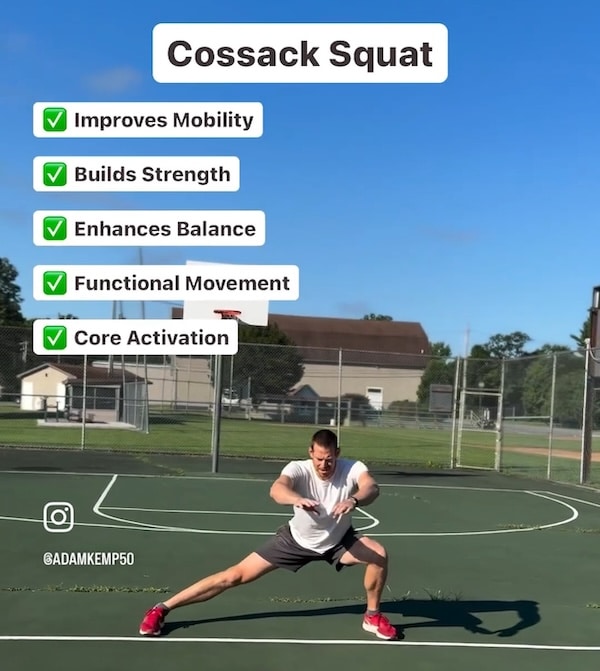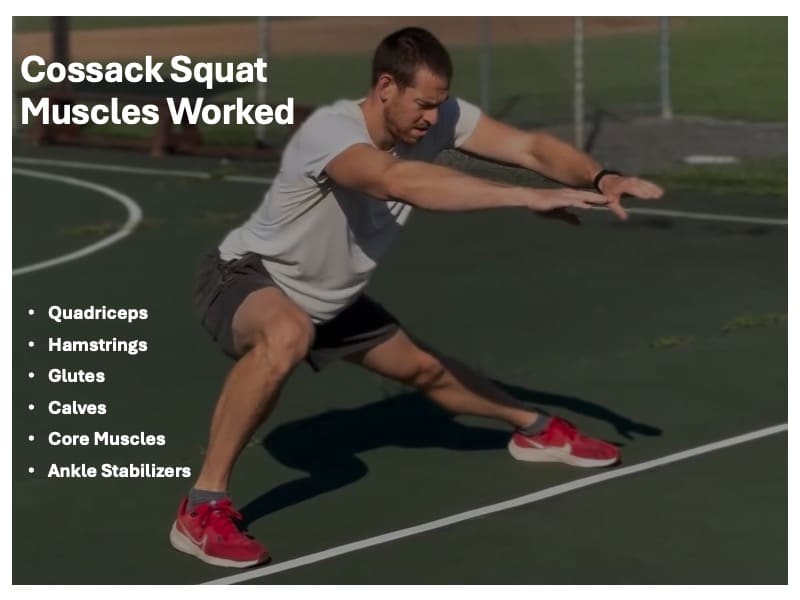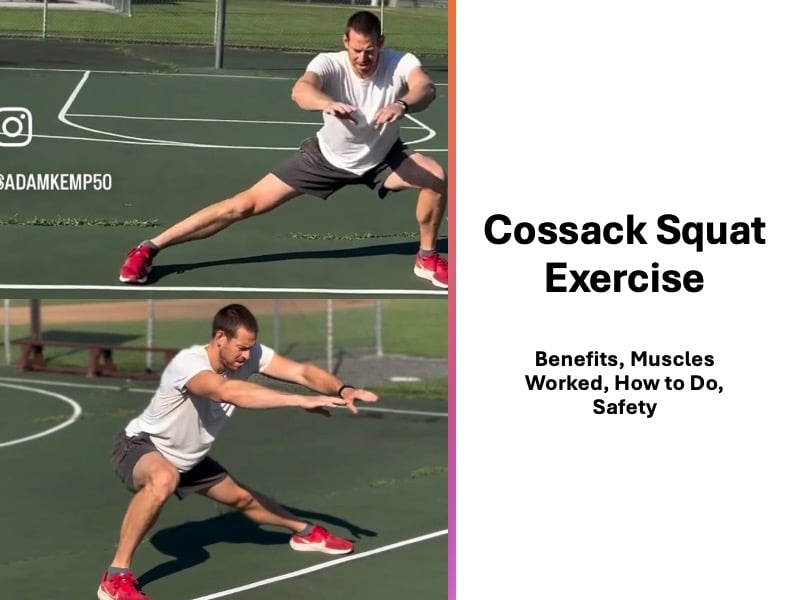Cossack Squat Exercise: Benefits, Muscles Worked, How to Do
As a professional basketball player, the Cossack squat is one of my all-time favorite leg exercises.
Being able to perform loaded Cossack squats has made a huge difference in building lateral strength, playing better on-ball defense, and staying pain-free throughout my career.
Fortunately, in my experience, the Cossack squat isn’t just great for athletes; it’s one of the best lower-body movements for improving hip, knee, and ankle health.
If you’re dealing with hip tightness or low back discomfort, learning how to do this exercise correctly can help you feel stronger, move more freely, and train with greater longevity.
By combining mobility, unilateral strength, and functional control, the Cossack squat offers a unique movement pattern that fills a critical gap in most training programs.
Learning how to do a Cossack squat properly can improve lower-body strength, increase athletic performance, and significantly improve hip and ankle mobility, all of which are crucial for injury prevention and daily movement efficiency.
Unlike traditional squats, which primarily train up-and-down movement patterns, the Cossack squat introduces a lateral (side-to-side) component to training, developing muscles that are often neglected.
Whether you’re an athlete, a weekend warrior, or someone trying to build joint resilience, this movement deserves a place in your routine.
This guide will explain everything you need to know, from how to do the Cossack squat safely to what muscles it works, plus common mistakes to avoid and tips for improvement!
What Is the Cossack Squat Exercise?
The Cossack squat is a lower-body exercise where you shift your weight to one leg, squatting deeply while extending the other leg straight out to the side with the toes pointing up.
Unlike traditional squats, the Cossack squat trains lateral movement, improving hip, groin, and ankle mobility while building unilateral strength and balance.
Proper form emphasizes an upright torso, a flat foot on the squatting leg, and strong core engagement to maintain control.
If you’re new to doing Cossack squats, start with a shallow range of motion and progress deeper as flexibility and strength improve.
Benefits of the Cossack Squat

Adding Cossack squats to your training routine offers far more than just a new movement pattern.
This exercise builds strength, improves joint mobility, develops balance, and boosts functional athleticism, which are all critical components for both sports performance and everyday health.
For these reasons, the Cossack squat is an efficient and highly valuable addition to any lower-body workout program.
Improves Lower-Body Mobility
The Cossack squat significantly improves flexibility in the hips, knees, and ankles. Its lateral movement stretches the adductors, hamstrings, and hip flexors, which are areas often neglected in traditional squats.
Regular practice can lead to increased range of motion, benefiting both athletic performance and daily activities.
Builds Unilateral Strength
This single-leg exercise targets the quadriceps, hamstrings, glutes, and adductors, promoting balanced muscle development.
The unilateral nature of the movement helps identify and correct muscle imbalances, enhancing overall lower-body strength and stability .
Improves Balance and Proprioception
By shifting weight laterally, the Cossack squat challenges your balance and proprioceptive abilities.
This can lead to better coordination and stability, which are crucial for both sports performance and injury prevention .
Strengthens the Core
Maintaining an upright torso during the Cossack squat requires significant core engagement, making it one of the best alternatives to crunches.
This not only strengthens the abdominal and lower back muscles but also improves spinal stability during dynamic movements.
Promotes Functional Movement Patterns
The Cossack squat mimics natural side-to-side movements, making it a functional exercise that translates well to real-life activities.
Research shows that exercises emphasizing controlled joint movement and single-leg stability, such as lunges and lateral squats, can significantly improve lower-limb strength, balance, and coordination, which are critical for injury prevention and athletic performance (Gao et al., 2022).
Incorporating it into your routine can improve movement efficiency and reduce the risk of injury during daily tasks.
Cossack Squat Muscles Worked

One of the greatest benefits of Cossack squats is its ability to simultaneously train strength, stability, and mobility by engaging multiple major muscle groups across the lower body and core.
This makes it an exceptional exercise for improving functional movement patterns and athletic performance.
Here’s a breakdown of the primary muscles worked during the Cossack squat exercise:
Quadriceps
The deep bending of the squatting leg heavily activates the quadriceps, helping to build strength, muscular endurance, and joint protection around the knees.
Hamstrings
As you lower and control the descent, the hamstrings stabilize both the squatting and extended legs, helping maintain balance and deceleration control.
Glutes
The gluteus maximus powers the ascent back to standing, while the gluteus medius plays a critical role in stabilizing the hips during the lateral movement. Strong glutes are essential for pelvic alignment and injury prevention.
Adductors (Inner Thighs)
The adductor muscles work hard to control the extended leg and assist in pulling your center of mass over the squatting leg, supporting both strength and flexibility across the hips and groin.
Calves
The calves, particularly the soleus muscle, contribute to ankle stability during the lowering phase and assist with balance during the lateral shift.
A stable ankle is crucial for preventing injuries and supporting smooth, coordinated movement.
Core Muscles
Throughout the entire movement, your core, especially the obliques and deep stabilizers like the transverse abdominis, must stay engaged to maintain an upright torso and prevent spinal collapse.
A strong, active core not only protects the lower back but also improves balance and power transfer between the upper and lower body.
Ankle Stabilizers
Muscles surrounding the ankle joint, including the tibialis anterior and the intrinsic muscles of the foot, work dynamically to stabilize and adjust to shifting weight loads.
Improved ankle control can improve movement efficiency and reduce the risk of sprains.
By targeting these muscles in a coordinated fashion, the Cossack squat offers a comprehensive lower-body workout that develops mobility, stability, strength, and athletic resilience.
How to Do a Cossack Squat
Mastering proper form is essential to get the full benefits of the Cossack squat while minimizing the risk of injury.
Here’s a simple step-by-step guide on how to do a Cossack squat correctly.
- Start with your feet wide apart, toes slightly pointed out.
- Shift your weight to one leg, bending the knee deeply while keeping the other leg extended straight with toes pointing up.
- Keep your chest tall and core engaged, avoiding rounding your back.
- Lower as far as your mobility allows, keeping the squatting foot flat on the floor.
- Push through your heel to return to the starting position, then shift to the other side.
Move slowly and with control to maximize strength, balance, and flexibility gains.
Safety Tips
While the Cossack squat offers numerous benefits, it’s essential to execute the movement correctly to avoid injury and maximize its effectiveness.
Whether you’re looking to improve your athletic performance or simply improve your functional fitness, the Cossack squat is a versatile and effective single-leg exercise that can take your lower body workouts to the next level!
Here are a few tips to help you master the Cossack squat:
Start with a Proper Warm-Up
Before doing Cossack squats, make sure your muscles are adequately warmed up.
Incorporate dynamic stretches, particularly focusing on the hips, hamstrings, and ankles.
Focus on Form Over Depth
When starting out, prioritize proper form rather than trying to achieve the deepest squat possible.
Maintain an upright torso, keep your chest up, and ensure your knees track over your toes.
As your flexibility improves, you can gradually increase the depth of your squat.
Use Assistance if Needed
If you’re struggling with balance or flexibility, use a support, such as holding onto a resistance band or placing a hand on a sturdy surface.
This will help you maintain balance and control as you build strength and flexibility.
Control Your Movements
Avoid rushing through the movement. The Cossack squat exercise is as much about control as it is about strength.
Slowly shift your weight from side to side, focusing on smooth, controlled movements.
This will engage more muscles and improve your overall stability.
How to Add the Cossack Squat to Your Workout Routine
Integrating the Cossack squat into your training can elevate your lower-body strength, mobility, and athletic performance.
Whether you’re focused on general fitness, sports performance, or injury prevention, there are several smart ways to include this versatile exercise.
Regardless, consistency is key.
Performing the Cossack squat 2–3 times per week can noticeably improve hip mobility, lateral strength, and balance over time, making it a valuable long-term addition to your workout program.
As Part of Your Warm-Up
Perform 2–3 sets of 5–8 Cossack squats per side toward the end of a proper dynamic warm-up. Moving through a controlled range of motion will dynamically open up the hips, groin, and ankles, preparing your body for more demanding exercises like squats, lunges, or sprint work.
During Leg Day or Strength Sessions
Add Cossack squats as a primary accessory exercise after compound lifts like barbell squats or deadlifts. Perform 3–4 sets of 8–12 controlled reps per side to build unilateral strength, improve joint stability, and develop lower-body resilience.
Pro Tip: Pair Cossack squats with side planks to create a powerful lateral strength and stability circuit. While Cossack squats strengthen the hips, ankles, and inner thighs through dynamic movement, side planks target the obliques and deep core stabilizers.
Together, they build resilience across the entire side of your body, improving balance, posture, and athletic performance. Try 8–10 Cossack squats per side followed by a 30–45 second side plank on each side for 2–3 rounds.
In Mobility or Active Recovery Workouts
On lower-intensity days, use the Cossack squat with lighter effort and slower tempo to focus on flexibility, balance, and muscle control. You can combine them with exercises like deep goblet squats, hip airplanes, or lateral lunges for a full mobility circuit.
Progressive Overload Options
As you become stronger and more mobile, progress the exercise by holding a light dumbbell or kettlebell in a goblet position, increasing time under tension, or pausing at the bottom of the squat to further challenge stability and strength.
Cossack Squat vs Lateral Lunge: What’s the Difference?
While the Cossack squat and the lateral lunge look similar, they serve slightly different purposes.
In a Cossack squat, you move slowly and deeply into a squat position over one leg, keeping the opposite leg fully extended with toes pointing upward. The focus is on mobility, flexibility, and controlled strength, especially through the hips, groin, and ankles.
On the other hand, a lateral lunge typically involves stepping out to the side into a lunge position, then pushing back to the starting position.
It emphasizes dynamic strength, power, and coordination rather than static flexibility.
Both exercises are valuable, but the Cossack squat is better for developing deep hip mobility and single-leg stability, while the lateral lunge is ideal for building explosive side-to-side strength and agility.
Final Thoughts: Is the Cossack Squat a Good Exercise?
The Cossack squat is one of the most valuable single-leg exercises for developing lower-body strength, mobility, balance, and functional athleticism.
By targeting the hips, knees, ankles, and core, it not only builds muscular endurance but also improves joint stability and movement efficiency, which are critical components for injury prevention and long-term athletic performance.
Research on similar unilateral exercises, such as lunges, has shown that controlled, multi-joint movements significantly improve lower-limb biomechanics and balance (Gao et al., 2022).
The Cossack squat uniquely reinforces these adaptations through lateral movement patterns that are often missing from traditional strength programs.
Whether you’re an athlete, a recreational fitness enthusiast, or someone looking to improve overall mobility and joint health, the Cossack squat is an outstanding exercise to incorporate into your routine.
With proper technique and consistency, it offers a high return on investment for strength, flexibility, and resilience.
Frequently Asked Questions About the Cossack Squat Exercise
This website does not provide medical advice. This website site does contain affiliate links, and purchases may earn a commission.
Read my Medical Disclaimer, Review Disclaimer, and Publishing Policies for more details. Use of this site indicates acceptance of these terms.



